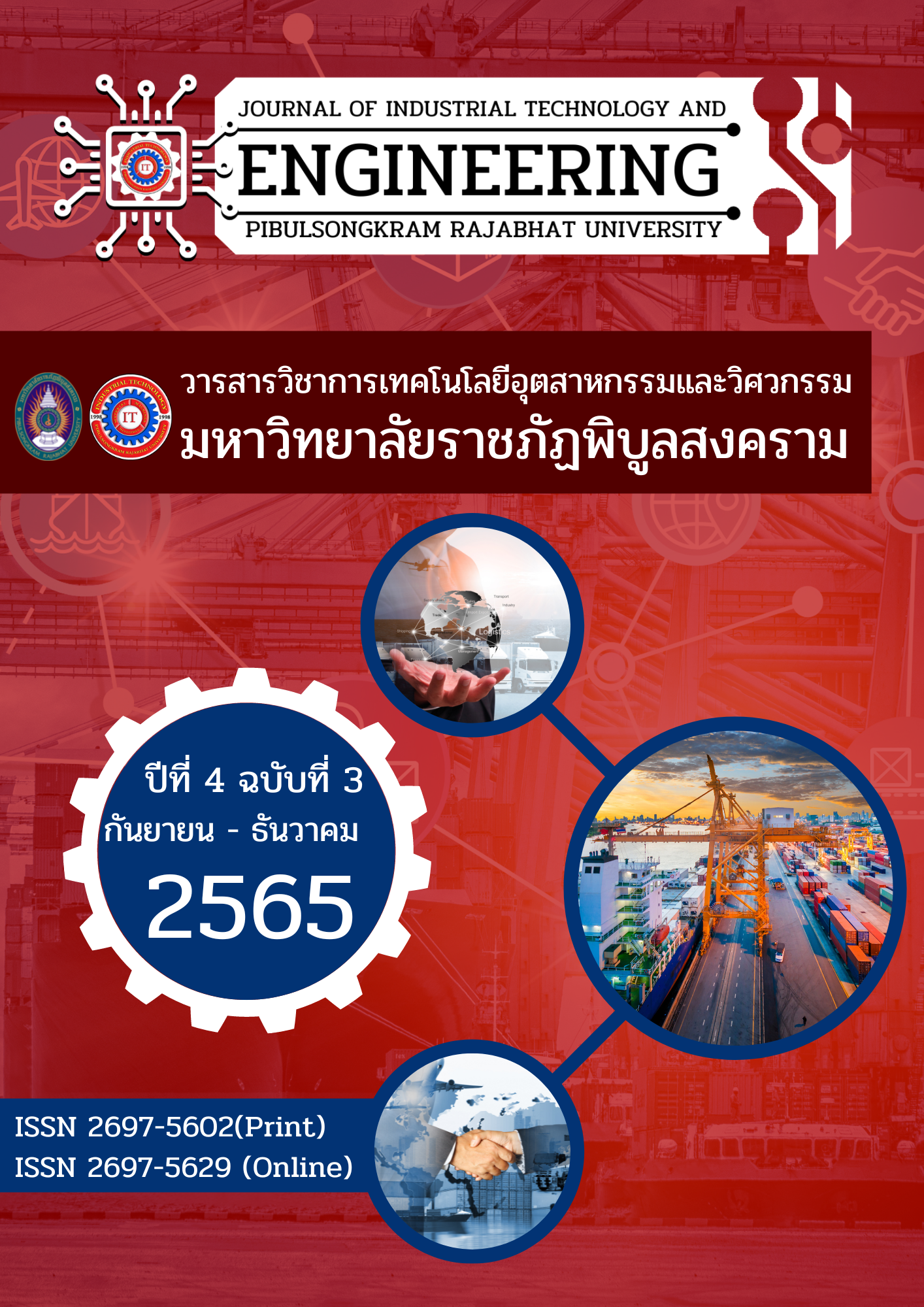การศึกษาสมรรถนะเครื่องอบแห้งเส้นหมี่ขาวด้วยลมร้อน แบบไหลผ่านทางเดียว
คำสำคัญ:
การอบแห้ง, เครื่องอบแห้งลมร้อน, เส้นหมี่ขาวบทคัดย่อ
งานวิจัยนี้มีวัตถุประสงค์ศึกษาสมรรถนะเครื่องอบแห้งเส้นหมี่ขาวด้วยลมร้อนแบบไหลผ่านทางเดียวที่มีการแปรผันอุณหภูมิอบแห้งและความเร็วลมร้อนภายใต้เงื่อนไขอุณหภูมิการอบแห้ง 45, 50 และ 55 ֯C และความเร็วลมร้อน 1.0, 1.5 และ 2.0 m/s โดยใช้สัดส่วนความชื้น อัตราการอบแห้ง และความสิ้นเปลืองพลังงานจำเพาะที่ได้รับการทดสอบในการประเมินสมรรถนะของเครื่องอบแห้ง ผลการศึกษาพบว่า กรณีอุณหภูมิอบแห้ง 55 ֯C และความเร็วลมร้อน 2 m/s จะให้ค่าสัดส่วนความชื้นต่ำที่สุดเท่ากับ 0.162 โดยค่าความชื้นเส้นหมี่ขาวสุดท้ายเท่ากับ 15.83 %d.b. หรือกล่าวอีกนัยหนึ่งคือ การเพิ่มขึ้นของอุณหภูมิอบแห้งเฉลี่ย 10% จะทำให้สัดส่วนความชื้นลดลง 9.83% และการเพิ่มขึ้นของความเร็วลมร้อนเฉลี่ย 40% จะทำให้สัดส่วนความชื้นลดลง 6.76% อัตราการอบแห้งสูงสุดเท่ากับ 0.74 kg/h และความสิ้นเปลืองพลังงานจำเพาะต่ำที่สุดเท่ากับ 6.013 MJ/kg นอกจากนั้นได้ทำการศึกษาจลพลศาสตร์เครื่องอบแห้งเส้นหมี่ขาวด้วยลมร้อนแบบไหลผ่านทางเดียวเปรียบเทียบกับผลที่ได้จากการทดลองพบว่า สมการ Two term สามารถทำนายผลการอบแห้งเส้นหมี่ขาวด้วยลมร้อนแบบไหลผ่านทางเดียวได้ดีที่สุด โดยให้ค่า R2 เท่ากับ 0.999023944 ซึ่งเป็นค่าที่มากที่สุด และค่า RMSE เท่ากับ 0.008964633 ซึ่งเป็นค่าที่น้อยที่สุด โดยเมื่อนำค่าที่ได้จากการคำนวณตามรูปแบบของสมการ Two term มาเปรียบเทียบกับผลที่ได้จากการทดลอง พบว่า ผลการเปรียบเทียบดังกล่าวมีความสอดคล้องกันเป็นอย่างดี
เอกสารอ้างอิง
Huelsz G and Rechtman R. Heat transfer due to natural convection in an inclined square cavity using the lattice Boltzmann equation method. International Journal of Thermal Sciences. 2013;65:111-119.
Min Xu, Ying Wud, Gary G Hou and Xianfeng Du. Evaluation of different tea extracts on dough, textural, and functional properties of dry Chinese white salted noodle. LWT - Food Science and Technology. 2019;101:456–462.
Kun Yu, Hui-Ming Zhou, Ke-Xue Zhu, Xiao-Na Guo and Wei Peng. Physicochemical changes in the discoloration of dried green tea noodles caused by polyphenol oxidase from wheat flour. LWT - Food Science and Technology. 2020;130:109614.
Jeevarathinam G, Pandiselvam R, Pandiarajan T, Preetha P, Balakrishnan M, Thirupathi V and Anjineyulu Kothakota. Infrared assisted hot air dryer for turmeric slices:Effect on drying rate and quality parameters. LWT - Food Science and Technology. 2021;144:111258.
Dongxu Liu, Shixin Song, Li Tao, Lei Yu and Jingyi Wang. Effects of common buckwheat bran on wheat dough properties and noodle quality compared with common buckwheat hull. LWT - Food Science and Technology. 2022;155:112971.
Zhenhua Wang, Yingquan Zhang, Bo Zhang, Fuguang Yang, Xiaolei Yu, Bo Zhao and Yimin Wei. Analysis on energy consumption of drying process for dried Chines noodles. Applied Thermal Engineering. 2017;110:941–948.
Basman A. and Yalcin S. Quick boiling noodle production by using infrared drying. Journal of Food Engineering. 2011;106:245–252.
Xiaolei Yu, Zhenhua Wang, Yingquan Zhang, Syed Abdul Wadood and Yimin Wei. Study on the water state and distribution of Chinese dried noodles during the drying process. Journal of Food Engineering. 2018;233:81-87.
Imkyung Oh and Suyong Lee. Rheological, microstructural, and tomographical studies on the rehydration improvement of hot air-dried noodles with oleogel. Journal of Food Engineering. 2020;268:109750.
Hyukjin Kwon, Geunhyuk Yang, Sungmin Jeong, Jaepil Roh and Suyong Lee. Establishment of machine learning hyperparameters for predicting the extensional properties of noodles from the thermo-mechanical properties of wheat flour. Journal of Food Engineering. 2022;321:110940.
Xiao-Na Guo, Shao-Hua Wu and Ke-Xue Zhu. Effect of superheated steam treatment on quality characteristics of whole wheat flour and storage stability of semi-dried whole wheat noodle. Food Chemistry. 2020;322:126738.
Xiaoyan Song, Wei Zhu, Yaqiong Pei, Zhilu Ai and Junying Chen. Effects of wheat bran with different colors on the qualities of dry noodles. Journal of Cereal Science. 2013; 58:400-407.
Shiyu Zeng, Bo Wang, Weiqiao Lv, Lijun Wang and Xiaojun Liao. Dynamic analysis of moisture, dielectric property and microstructure of ginger slices during microwave hot-air flow rolling drying. Food Control. 2022;134:108717.
Chang Chen and Zhongli Pan. Heat and moisture transfer studies on walnuts during hot air drying in a fixed-bed column dryer. Applied Thermal Engineering. 2021;199:117554.
Noemi Baldino, Domenico Gabriele, Francesca Romana Lupi, Bruno de Cindio and Lucio Cicerelli. Modeling of baking behavior of semi-sweet short dough biscuits. Innovative Food Science and Emerging Technologies. 2014;25:40–52.
Jie Yu Chen, Han Zhang and Yelian Miao. The Effect of Quantity of Salt on the Drying Characteristics of Fresh Noodles. Agriculture and Agricultural Science Procedia. 2014;2:207–211.
Zi-Jun Weng, Be-Jen Wang and Yih-Ming Weng. Preparation of white salted noodles using rice flour as the principal ingredient and the effects of transglutaminase on noodle qualities. Food Bioscience. 2022;33:100501.
Abimbola Kemisola Arise, Kemi Funmi Oriade, Tobechukwu Nnaemeka Asogwa and Ifeanyi Nwachukwu. Amino acid profile, physicochemical and sensory properties of noodles produced from wheat-Bambara protein isolate. Measurement:Food. 2022;5:100020.



